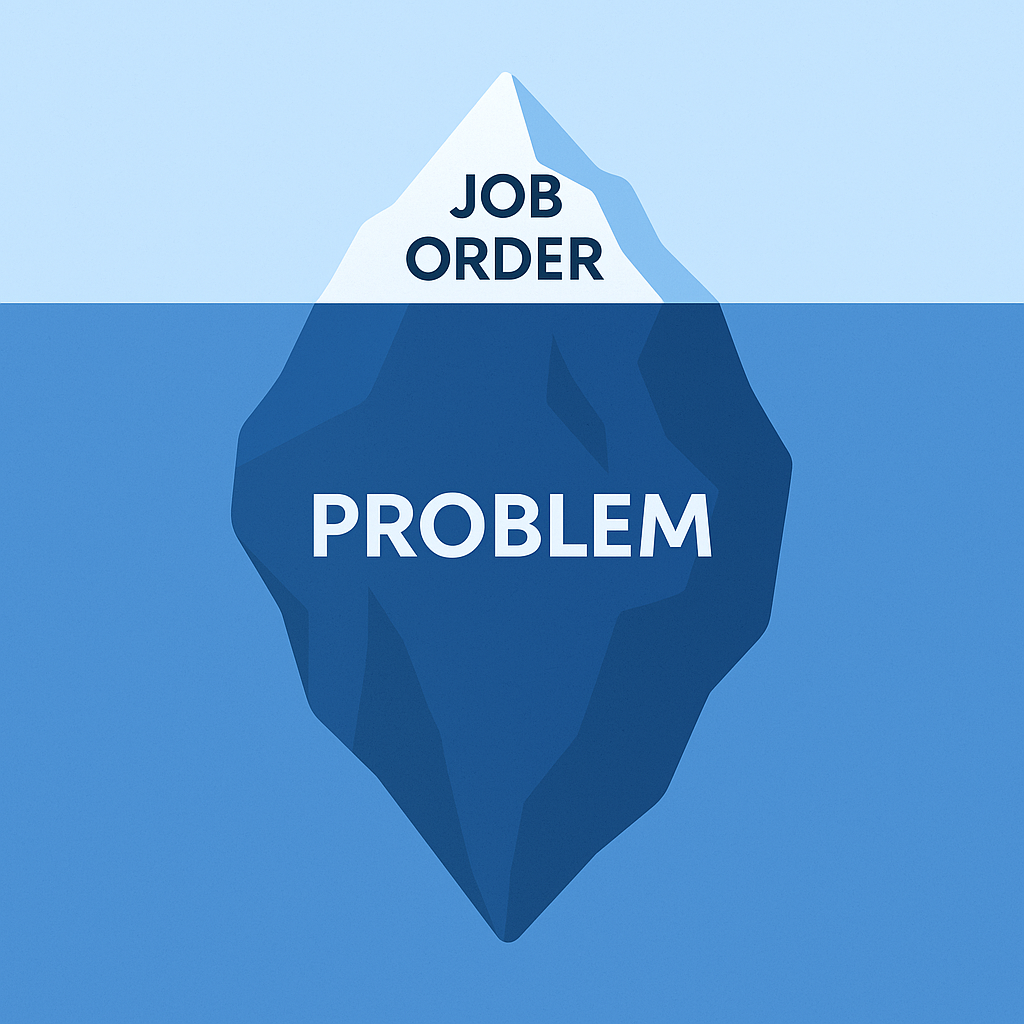Selling With Your Consultant
In my previous post, How to Prevent Unexpected Contract Terminations, I shared how systemizing consultant and client check-ins at key milestones...

Since forever, staffing sales professionals have been trained to seek out job orders.
Most call hiring managers and ask:
That is the job, but here is the harsh truth
This is not selling.
In a difficult market with economic uncertainty where job orders are quickly drying up, asking these questions doesn’t get the job done.
Today I’m going to show you how to find and frame a problem as a growing threat that ties directly to an executive KPI that creates urgency and aligns multiple stakeholders around the need to take action.
Here is why this is important.
What Happens in a Company Before a Job Order Becomes a Job Order?
A job order doesn’t start with HR writing a job description.
A job order doesn’t start with the approval from procurement or the CFO.
All job orders (consulting and FTE hires) are born out of a problem or a goal.
For example:
At first, the business tries to solve the problem internally.
They shift priorities, reassign staff, stretch team bandwidth, extend timelines or pivot in a new direction. Only after those options fail—and the cost of doing nothing becomes so high—do they consider investing in an external solution (consultants, FTE, software, etc).
Even if they determine they have to buy a solution to solve a problem they still put that purchase off until it becomes absolutely necessary. They do this not because they’re procrastinating, but because it is the reality of running a business.
They ask themselves, of all of the initiatives we need to act on, which are the most important and top priority right now? While all businesses have unlimited opportunity for improving operations, all businesses also have limited resources from which to pull from, and an obligation to go through a valuation and prioritization process.
They develop a list of projects and initiatives and put them through a process of valuation and prioritization. The process may be formal or informal. Factors that influence prioritization may include:
of valuation and prioritization. The process may be formal or informal. Factors that influence prioritization may include:
A line has to be drawn, above which are projects that can be approved, staffed and funded, below which are those that cannot be approved.
This is how job orders are born.
Most likely, you and your sales team are never in the room for these conversations.
You should be. And I’m going to teach you how.
Your Job Isn’t to Find a Job Order. Your Job is to Find & Frame a Problem.
“Pain” can be defined as a problem, critical business issue, technical issue or potential missed opportunity. If a person or a company doesn’t have pain, why should they change or leave the status quo? Pain is what gives people a reason for change. Pain causes people to take action, to change a negative situation.
When prospecting, you will encounter two types of customers.
Buyers who are not actively seeking a solution and not actively trying to resolve an issue. A problem exists (with their team, product or project), but the buyer is not yet aware of it, either because they’re uniformed or they have rationalized that a solution doesn’t exist.
Uninformed buyers simply don’t know the problem exists — either because it hasn’t surfaced yet, or they lack visibility into the root cause or consequences.
Rationalization means they are aware of the problem but they are not aware a solution exists. They may have failed at previous attempts to solve the problem and given up on a solution.
Your job with these buyers is to help them become aware of, understand and contextualize their problems including the cost of the problem going unresolved.
This is selling.
You will also encounter buyers who are open and willing to discuss their problems, challenges, or dissatisfaction but they don’t know how to solve them. An example of this is a leader dealing with technical debt. Every technology leader knows that technical debt leads to more bugs and product defects, higher maintenance costs, and delayed time-to-market with new products and features, but they’re sitting on the sidelines.
Why?
They don’t have a clear vision of what to do or how to get started.
Your job is to fully diagnose the problem, its impact, and co-create a vision of a solution with the buyer.
This is selling.
How to Frame a Problem
You might uncover a pain point—like a legacy system that frustrates end users—but that’s not enough. You need to go deeper and frame it as a high-cost, high-priority threat that execs care about—something that gets worse the longer it’s ignored.
Framing a problem means to define it clearly, shape how it's perceived, and position it in a way that creates urgency and alignment across multiple stakeholders.
Framing a problem is about helping the customer see:
Frame the problem by writing a problem statement. A problem statement is a clear, concise description of an issue that needs to be addressed or resolved. In business contexts, it's used to articulate what the customer is struggling with, why it matters, and what’s at stake if it doesn’t get solved. Problem statements serve a variety of important purposes across different departments—especially in sales, consulting, product development, project management, and strategic planning.
Find a Problem
Instead of trying to find pre-defined, budget approved job orders, your job is to find a problem that’s already costing the business time, money, or momentum.
Frame the problem as a growing threat—not just a pain point, but a risk to a priority that executives are investing in. Show that staying the course is more costly than taking action.
Align the buying team around that framing by writing a clear, compelling problem statement—one that gets validated by multiple stakeholders, highlighting the consequences of inaction, and ties directly to executive-level metrics.
If you’re still waiting for prospects to hand you job orders, good luck!
The best salespeople create job orders. They do it by helping them recognize and frame the problems worth solving and aligning their teams toward a solution. That’s how real value is created—and where real influence begins.

In my previous post, How to Prevent Unexpected Contract Terminations, I shared how systemizing consultant and client check-ins at key milestones...

About a year ago, I was serving as the fractional revenue leader, managing sales and recruiting for a client.

If you’ve worked in staffing long enough, you’ve been trained to chase job orders.